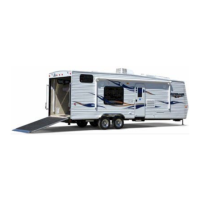will turn bright green. When the cylinder
becomes empty, the indicator will change to
bright orange. Now turn the regulator lever to
the side of the “reserve” cylinder and the green
signal should return. You may now remove the
empty cylinder to have it refilled without
interrupting the flow from the full bottle. After
filling the cylinder, connect the pigtail hose and
slowly open the bottle valve.
HOSES,PIPES,TUBES &FITTINGS
The hoses, pipes, tubes and fittings used in
your propane system are designed to
withstand pressures exceeding those of the
propane system. However, because
environment and time can both contribute to
the deterioration of these components, they
must be inspected for wear at regular intervals.
Be sure to inspect the hose before each
season and when having the tank refilled.
Look for signs of deterioration such as cracks
or loss of flexibility. When replacing the hose or
other propane components, make sure to
always replace them with components of the
same type and rating (check with your dealer).
Fittings are used to connect the various
system components to each other. The P.O.L.
fitting at the end of the propane supply hose is
made of brass so that pipe sealants are not
necessary to prevent leaking. It also has a
left-handed thread, which means that it is
turned clockwise to remove, and
counter-clockwise to tighten. The P.O.L. fitting
has been designed to help restrict the flow of
LP gas in the event of a regulator failure or
hose malfunction.
USING THE PROPANE SYSTEM
After the RV is completely set up and you are
prepared for camping enjoyment, use the
following steps for propane operation:
1. Close ALL burner valves, controls and pilot
light valves.
2. Open the main valve in the propane
container slowly to avoid a fast rush of
propane vapor through the excess flow
valve causing propane “freeze.” Should
you experience propane “freeze-up”, close
the main valve and wait 15 minutes before
trying again.
3. Listen carefully as propane begins to flow.
If a hissing noise is heard for more than
one or two seconds, close the main valve
and contact your dealer to have the
propane system tested.
4. Light the appliances as needed and
directed in the appropriate appliance
manufacturer’s owner manual located in
the Goodie Bag.
Make sure that you read and fully understand
ALL safety requirements for handling and
operation of the propane system. The Goodie
Bag contains OEM operator’s manuals for the
various appliances hooked to your propane
system. The propane system provides added
benefits to your camping enjoyment; however,
it must be handled with care. If you have any
questions or concerns, consult with your
dealer and/or the specific OEM.
If you have double cylinders on your RV, use
only one at a time. Otherwise, the propane
supply will be drawn equally from both
cylinders until the supply has been totally
exhausted. Using one cylinder until it is empty,
then using the second cylinder will allow you to
fill the empty cylinder at your convenience
without running totally out of propane.
If flooding is predicted for your area, shut OFF
each propane cylinder valve before the water
rises. If the propane system has been flooded,
do not turn it back ON until it has been checked
by your dealer or a qualified propane service
technician.
64
SECTION 9
PROPANE SYSTEM
WARNING
Do not use portable fuel-burning
equipment, including wood and charcoal
grills and stoves, inside the RV. The use of
these items inside a RV may cause fires or
asphyxiation (inability to breathe).

